18 Trees with Black Berries or Berry-Like Fruits

Trees with black berries add vibrant colors to garden landscapes. Many tree varieties produce edible black fruits that provide tasty treats to humans and wildlife.
Common trees with black berries include the black mulberry tree, the black elderberry tree, and the black cherry tree. Additionally, attractive palm trees like the açaí palm and California palm produce delicious black fruits. Regardless of your taste in gardening, there are plenty of options for planting trees that produce black berries.
Trees with black berries are an excellent addition to any yard. Black fruit-producing trees help increase biodiversity by attracting birds and wildlife. Also, many medium-sized trees have dense foliage, providing welcome shade in summer landscapes. Therefore, planting trees with black berries can enhance the yard’s biodiversity, create a vibrant ecosystem, and provide a sustainable source of fresh fruit.
This article is a guide to various types of trees with black berries. Pictures and descriptions of fruit-producing berry trees will help you to identify the best types for your garden landscape. From the delicious black mulberry to tropical palm trees, you can find a suitable tree-producing black berries for your front or backyard.
Black Berries On Trees — Proceed With Caution
It’s crucial to be careful when picking black berries. For example, some varieties, like buckthorn trees (Rhamnus), have sharp thorns and can cause injury. However, some black berries or fruits from trees can be poisonous and cause stomach upset when consumed. Therefore, never consume black berries from trees without identifying the species.
How to Identify Trees With Black Berries
To identify trees with black berries, observe the tree’s overall appearance, leaf shape, and type of black berry. Examine the berries closely for size, shape, and texture. Some black berries are small round fruits growing in flat-topped clusters. In contrast, other types of black-colored tree berries look more like black raspberries.
This article refers to all types of black fruits growing on trees as berries—regardless of the fact they may not be berries in the botanical sense. A berry is a fleshy fruit produced from a single ovary, typically containing seeds in the pulp. However, some trees, like cherry trees, sweet laurels, and tupelo trees, have berry-like drupes or stone fruits.
Types of Trees With Black Berries (With Pictures) – Identification Guide
Let’s look in more detail at many kinds of trees that produce black-colored berries, drupe, and stone fruits.
Black Mulberry (Morus nigra)

Black mulberry fruit
Black mulberries are small dark purplish-black berries that grow on deciduous small mulberry trees. The berry-like fruits resemble elongated blackberries with tiny fruit clusters growing around a central stem. They have a sweet, slightly tart flavor and contain juicy, syrupy pulp. Fruits from black mulberry trees measure up to 1” (25 mm) long.

Black mulberry tree
Black mulberries look and taste like blackberries. You can use the black fruits to make pies, jams, jellies, and desserts. You can also eat the succulent black or dark purple berries straight off the tree. Compared to white and red mulberries, the black varieties are tastier. Mulberry tree fruits also attract birds and other wildlife.
Mulberry trees are also identified by their heart-shaped, dark green leaves. In the fall, mulberries have bright yellow foliage, making them valuable ornamental fruit trees for garden landscapes.
Laurel Tree / Sweet Bay (Laurus nobilis)
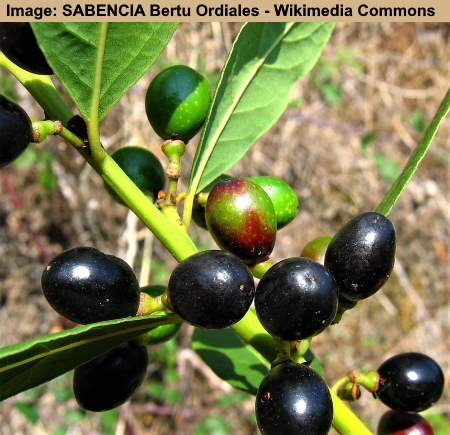
Laurel fruit
Laurel trees, also known as bay laurels, grow small, round, and shiny black berries when they’re ripe. The black, glossy, drupe-like berries measure 0.4” (10 mm) in diameter and grow in clusters on the small evergreen tree. Each small round berry contains a single seed that resembles a small black olive.

Laurel tree
Identifying features of bay laurel trees are their narrowly ovate, leathery leaves and clusters of greenish-yellow flowers that bloom in spring. Ideal for hedges and topiary, laurel trees grow 12 to 40 ft. (3.6 – 12 m) tall. The small tree is a popular container plant as the dried leaves are used in cooking.

Dried bay leaves
Sweet bay trees (Laurus nobilis) have leaves and berries that are safe for humans to eat. This is different from some other laurel shrubs used for hedging, which have toxic parts. Take the cherry laurel (Prunus laurocerasus), for instance. This plant is not related to the sweet bay and has small black berries that are poisonous, just like its seeds and leaves.
Black Elderberry (Sambucus nigra)

Black elderberries are identified as small, dark purple to black berries that grow in drooping clusters on elderberry trees. Appearing in the fall, the round berries measure approximately 0.15” to 0.25” (3 – 5 mm) in diameter. Before the berries appear, the deciduous tree blooms with flat-topped clusters of creamy-white flowers.

Black elderberry tree
Black elderberries are not typically eaten raw because they are poisonous. However, the berries and flowers become edible after cooking. Common uses for elderberries are for making syrups, jams, jellies, and wines. The black berries are also a favorite food source for birds and wildlife.
Black Cherry (Prunus serotina)

Black cherries
Black cherries grow on large, deciduous trees. The berry-like drupes appear red before ripening to dark purple-black. The tall cherry tree blooms in spring with clusters of creamy white flowers on arching branches. Other identifying characteristics are its conical habit, oblong, glossy green leaves, and abundant clusters of black cherries.

Black Cherry (Prunus serotina)
The small, round, black berry-like fruits measure 0.19” to 0.4” (5 – 10 mm) in diameter. Black cherry tree leaves are 5” (13 cm) long, and the finger-like flower clusters are 6” (15 cm) long. The tall, deciduous fruit tree measures 50 to 80 ft. (15 – 24 m) tall. The flowers attract Eastern Tiger Swallowtail butterflies.
The edible fruit from black cherry trees tastes better when growing in a sunny location. In the shade, the black “berries” can have a sweet and tart flavor. You can eat black cherries fresh off the tree as a delicious and healthy snack. You can also use the juicy black fruits to make jams, jellies, pies, and other desserts.
Common Buckthorn (Rhamnus cathartica)

Common buckthorn fruit
Common buckthorn is a large shrub or small tree identified by its small round black berries, golden yellow flowers, thorny branches, and smooth elliptical green leaves. The fleshy round drupes measure 0.25” to 0.5” (6 – 13 mm) in diameter. The berries ripen in the fall and remain on the fruit tree throughout the winter.
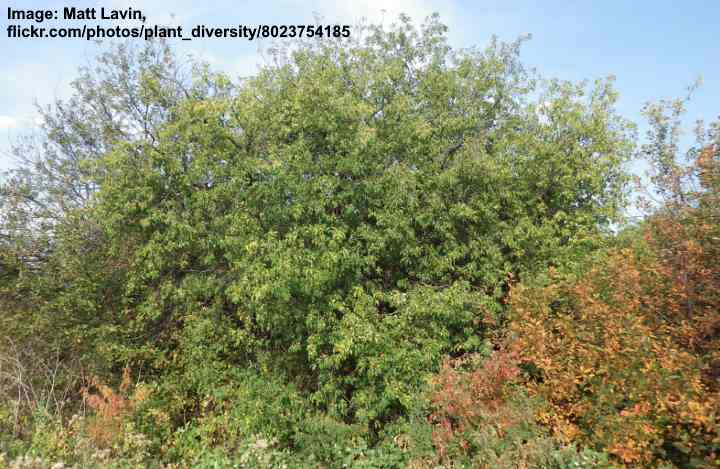
Common buckthorn tree
Common blackthorn berries are not poisonous. However, they have a powerful laxative effect and are rarely consumed. Therefore, the small yellow-flowering thorny shrub-like tree is planted for its landscaping value. Its flowers and black drupes have ornamental value. The plant works well in foundation planting, shrub borders, hedging, and as a windbreak.
Black Tupelo (Nyssa sylvatica)

Black tupelo fruit
Black tupelo—also called black gum tree—is a deciduous tree producing small, dark blue-black berries. The berry-like, egg-shaped drupes appear in late summer and measure 0.5” (13 mm) long. The black fruits grow in clusters on stalks 1.5” (38 mm) long. The fruits are edible and have a sour taste. However, they are a favorite food source for birds and wildlife.

Black tupelo tree is an ornamental deciduous tree that has beautiful fall colors
Black tupelo trees are known for their brilliant fall foliage, ranging from vibrant red to orange and deep purple shades. The leaves are elliptical and glossy green and measure 3” to 6” (5.7 – 15 cm) long. Black tupelo trees have a pyramidal shape and grow 40 to 70 ft. (12 – 21 m) tall.
Black tupelo berries are typically not eaten by humans because of their sour, acidic taste. However, you can sweeten the black berry-like fruits to make preserves. They are also a vital food source for many songbirds.
Black Hawthorn (Crataegus douglasii)

Black hawthorn leaves and fruit
Black hawthorn trees produce small purplish-black berry-like pomes. The edible “berries” emerge red and ripen to black in late summer and the fall. The small thorny tree is identified by its oval, leathery leaves, 5” (13 cm) long, thorny branches, clusters (corymbs) of white flowers, and attractive red, yellow, and orange fall foliage colors.

A cluster of several small hawthorn trees
Also called the western thornapple, the small fruit-bearing tree produces abundant black berries when planted in full sun. The black fruits measure 0.5” (13 mm) in diameter and can persist on trees through winter. The berries grow in clusters on hawthorn trees and attract birds and other wildlife.
Black hawthorns are ideal security barriers, privacy hedges, or foundation plantings thanks to their thorny branches and dense foliage. You can prune them easily to maintain their height around 6 to 8 ft. (1.8 – 2.4 m).
Juneberry (Amelanchier lamarckii)
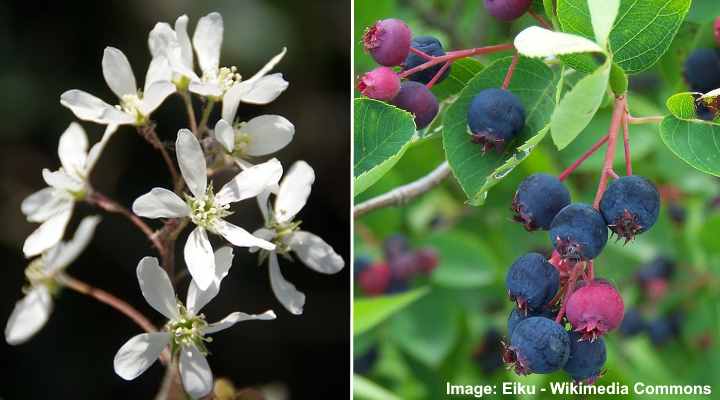
Juneberry flowers, fruit and leaves
Small juneberry trees produce round red berries that ripen to purple-black by early summer. The small, round black berries resemble blueberries. The dark, purplish berries measure 0.4” (10 mm) in diameter and have a sweet, juicy flavor with a hint of tartness reminiscent of apples.

Juneberry tree
Juneberry trees bloom in spring with clusters of white, star-shaped flowers. At the same time, bronze-red leaves emerge and turn dark green during the season. In the fall, the small trees are adorned with masses of black berries, contrasting with orange and red autumn foliage colors.
You can use juneberries in pies, jams, and other desserts. They are also delicious straight off the tree.
Black Persimmon (Diospyros texana)

Black persimmon (Diospyros texana)
Black persimmon is a small tree in the ebony family that produces fleshy, round black fruits. The black berry-like fruits are identified as sweet-tasting. They ripen on the tree from July to September. The round, black “berries” have smooth, shiny skin and measure up to 1” (25 mm) in diameter. Black persimmons taste like prunes.
Apart from the round, fleshy black fruits, identifying features of black persimmon are its white, urn-shaped flowers and dark green tear-shaped (obovate) leaves. The small trees or large multi-stemmed shrubs grow 30 to 45 ft. (9 – 13 m) tall. Apart from delicious black fruits, black persimmon is a beautiful ornamental tree.
Pagoda Dogwood (Cornus alternifolia)
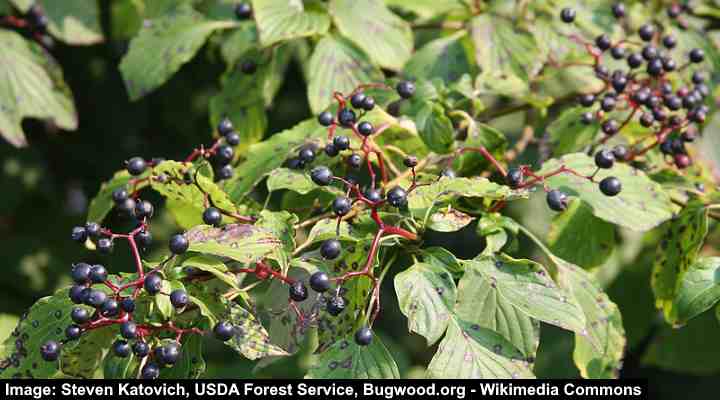
Pagoda dogwood fruit
Pagoda dogwood is a small ornamental white-flowering tree that produces small bluish-black berries. The showy black berry-like drupes grow on orangish-red stems. Each berry contains a single seed and measures about 0.25” (6 mm) in diameter. The attractive tree, with its horizontal branching pattern, grows 15 to 25 ft. (4.5 – 7.5 m) tall.

Pagoda dogwood tree and flowers
Pagoda dogwoods get their name from the plant’s unique branching structure, resembling a pagoda. The tree also produces clusters of creamy-white flowers in late spring. The oval-shaped leaves turn a deep red-purple color in the fall, adding to its ornamental value.
While the pagoda dogwood produces black berries, they are generally not suitable for human consumption due to their sour and bitter taste. However, these showy black-blue berries are a popular food source for various wildlife, including squirrels, pheasants, and grouse.
Devil’s Walking Stick (Aralia spinosa)

Devil’s walking stick flowers, leaves and fruit
Devil’s walking stick is a unique small tree known for its sharp thorns and clusters of small, purple-black berries. The spherical berry-like drupes ripen in late summer and fall, attracting birds to garden landscapes. The showy fruits appear on bright pink stalks and measure 0.25” to 0.3” (6 – 8mm) in diameter.

Devil’s walking stick trees
Other characteristics of devil’s walking stick trees are creamy-white flowers blooming in large clusters 1 to 4 ft. (0.3 – 1.2 m) tall. It also has huge, lobed, dark blue-green leaves covering its umbrella-like canopy. The berries of the devil’s walking stick are not typically edible and can be mildly toxic if ingested raw.
Indian Blackberry (Syzygium cumini)

Indian blackberry fruit
Indian blackberry is a tropical fruit tree that produces large black berry-like drupes. The black fruits are oblong or egg-shaped and are green when unripe and gradually blacken as they ripen. Indian blackberries measure 0.5” to 2” (13 – 50 mm) long and have a sweet, mildly astringent taste.

Indian blackberry tree
Also called jambul tree or black plum tree, the large tree thrives in Florida, growing up to 100 ft. (30 m) tall. It’s characterized by rough bark, glossy, aromatic dark green leaves, and white flowers blooming in clusters.
Maqui or Chilean Wineberry (Aristotelia chilensis)

Maqui berries
Chilean wineberry trees produce small, round, edible black berries with a tart taste like blackberries. The small spherical berries measure 0.16” to 0.24” (4 to 6 mm) in diameter. Also called maqui berries, the fruit clusters appear after white flowers have finished blooming.

Maqui tree
Chilean wineberry shrub-like trees are relatively small, typically growing 13 to 16 ft. (4 – 5 m) tall. The ornamental fruit trees are popular for garden landscapes in USDA zones 8 to 12. The shrub or small tree can reach heights of up to 30 feet (9 meters).
The dark, glossy berries are used in sauces, jellies, and desserts. They have become popular as a superfood as they are rich in antioxidants, vitamins, and minerals.
Jabuticaba / Jaboticaba (Plinia cauliflora)
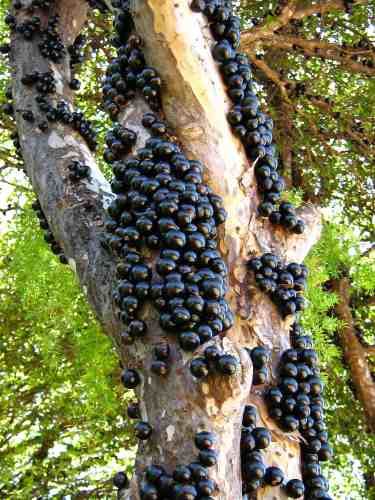
Jabuticaba tree
Jabuticaba is an evergreen tropical tree, easily recognizable because its small, round, black berries grow directly on the trunk and branches. The berries measure up to 1.6” (4 cm) in diameter, and have thick, leathery skin with a tart taste that is easily peeled. The fruit’s flesh is sweet and juicy.
The edible black berries of the jabuticaba tree have a short shelf life. Therefore, they are common ingredients for making tarts, fortified wines, jams, and liqueurs. It’s impossible to find jabuticaba berries in specialty fruit stores outside of their cultivation area.
The sun-loving, heat-tolerant ornamental tree is small to medium-sized, growing 50 ft. (15 m) tall. It has glossy, leathery leaves forming a dense canopy. The tree blooms with golden yellow or white flowers, followed by dark purple berries resembling grapes.
Palm Trees With Black Berry-Like Fruits
Several varieties of palm trees produce sweet-edible fruits like large dark-brown to black oblong berry-like drupes.
Açaí Palm (Euterpe oleracea)

Açaí palm fruit
Fast-growing açaí palm trees produce small, dark purple or black berries growing in huge clusters with up to 100 drupes. The black berry-like drupes grow in large clusters and are approximately 0.6” to 1” (15 – 25 mm) in diameter and look like round grapes.

Açaí palm tree
Each berry contains a single large seed, making up to 80 percent of the fruit. The berries have a nutty, chocolate-like flavor and an oily texture. Açaí palm trees can grow up to 80 feet (24 m) tall and have arching palm fronds 10 ft. (3 m) long.
Saw Palmetto (Serenoa repens)

Saw palmetto palm fruit
Saw palmetto is a type of palm tree native to Florida that produces small, round, reddish-black berries. The berries grow in dense clusters and reach up to 0.4” (1 cm) in diameter. They grow among fan-shaped, spiny palm leaves and look like clusters of black grapes. When dried, they have a wrinkled appearance and contain a hard seed.

Saw palmetto trees
Saw palmetto palms grow 4 to 8 ft. (1.4 – 2.4 m) tall and up to 6 ft. (1.8 m) wide. The palms are popular landscaping plants in tropical climates. They are ideal for foundation planting or mass planting to create a security barrier. The white or golden yellow flowers attract pollinators, and black saw palmetto berries are an important food source for wildlife.
Chinese Fan Palm (Livistona chinensis)

Chinese fan palm fruit
Chinese fan palm is an attractive ornamental palm tree that produces masses of dark gray-blue, almost black fruits. These dark-colored, oblong, olive-like berries grow in dangling clusters with between 50 and 100 fruits. Individual black fruits measure 0.5” to 1” (13 – 25 mm) in diameter.

A Chinese fan palm tree
Ornamental Chinese fan palm trees grow up to 30 ft. (9 m) tall and feature large, cascading, fan-shaped leaves. The emerald-green leaves are 3 to 6 ft. (0.9 – 1.8 m) across and are characterized by stiff, spine-covered petioles. The arching feature of the fan palm gives it a spectacular fountain-like appearance.
California Fan Palm (Washingtonia filifera)

California fan palm fruit
The California fan palm is a tall variety of palm tree producing black pea-sized fruits. Identifying features of the palm tree are its fan-like fronds measuring 3 to 6 ft. (0.9 – 1.8 m) long, creamy-white tubular flowers, and huge clusters of round black fruits. The palm tree grows up to 60 ft. (18 m) tall.

The ornamental California fan palm is identified by its fan shaped fronds
The California evergreen fan palm is a beautiful ornamental plant for USDA zones 8 to 11.
Related articles:
